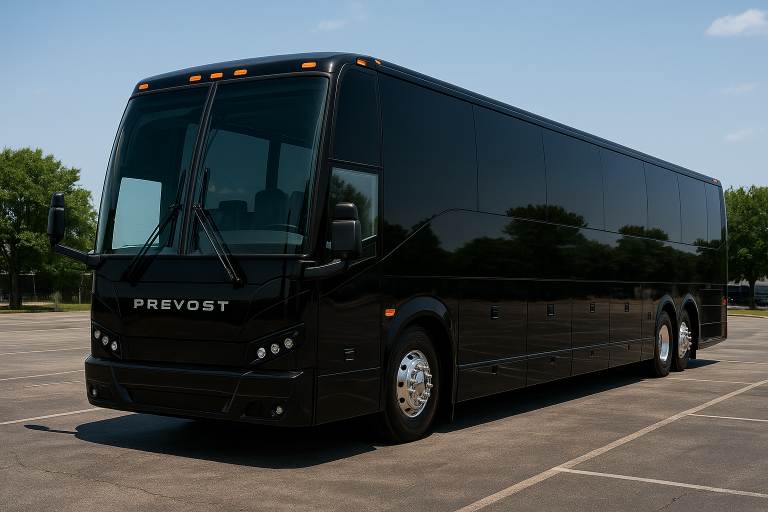- Charter Bus Rental Nashua /
- Blog /
- How to Stop Sickness on a Nashua Charter Bus
How to Stop Sickness on a Nashua Charter Bus
Motion sickness can strike any traveler, whether you’re booking a field trip charter bus to the Seacoast Science Center in Rye, a wedding shuttle up to Waterville Valley, or a school event trip down to Boston. The good news? Motion sickness is manageable—and even preventable—with the right strategies. Here’s how to keep your group feeling their best on every mile of your New Hampshire charter bus journey with Charter Bus Rental Nashua.

Quick Answer
If you’re already feeling queasy, move to a seat near the front of the bus and fix your gaze on a stable point in the distance (like the road ahead). Take slow, deep breaths, sip cool water, and open a window or overhead vent for fresh air. Avoid reading or looking at screens until symptoms subside. If possible, nibble plain crackers or ginger chews—or take an over-the-counter remedy like meclizine or dimenhydrinate if approved by your doctor.
What Is Motion Sickness?
Motion sickness is a common condition that causes nausea, dizziness, cold sweats, and sometimes vomiting when you travel by car, bus, boat, or plane. It happens because your brain receives conflicting signals about movement from your eyes, inner ears (vestibular system), and body. For example, while riding a bus through the winding roads of the White Mountains, your inner ear senses motion, but your eyes—focused on a book or phone—see a stationary object. This sensory mismatch triggers symptoms of motion sickness.
What Causes Motion Sickness?
Anyone can get motion sick, but some people are more susceptible than others. Risk factors include age (children ages 2–12 are especially prone), hormonal changes (pregnancy or menstruation), migraines, anxiety, and a family history of motion sensitivity. Triggers include sitting in seats where you feel more movement (like the back of the bus), reading or using electronic devices, strong odors, stuffy cabins, dehydration, and traveling on an empty or overly full stomach. Even seasoned travelers may experience motion sickness on long rides or unfamiliar routes—like taking a charter bus from Nashua to Quebec City for the first time.
6 Tips to Prevent Motion Sickness
Choose the Right Seat
Where you sit matters. On a charter bus, the smoothest ride is usually near the front and by a window, close to the vehicle’s center of gravity. Avoid seats over the rear wheels or at the very back, where swaying and bouncing are amplified—especially on bumpy roads like those leading to Mount Monadnock or Franconia Notch State Park. Facing forward helps align your visual cues with the motion sensed by your inner ear.
Focus on the Horizon
Looking out the window and fixing your gaze on a stable point in the distance (such as the horizon or the road ahead) can help resolve the sensory conflict that causes motion sickness. Avoid reading, texting, or watching videos during the trip—these activities increase the disconnect between what your eyes see and what your body feels. If you need to use your phone or tablet, do so briefly and infrequently.
Keep Fresh Air Circulating
A stuffy bus cabin can make nausea worse. Open a window or adjust an overhead vent to let in fresh air, or ask the operator to set the climate control to bring in outside air. Cool, moving air not only helps dissipate unpleasant odors (which can trigger queasiness), but also has a calming effect on your nervous system. If it’s safe and weather permits, request a brief stop to step outside and breathe deeply.
Eat Light and Stay Hydrated
Traveling on an empty stomach or after a heavy, greasy meal can both increase your risk of motion sickness. Eat a small, bland snack (like crackers, pretzels, or a banana) before boarding, and continue to nibble lightly throughout the trip. Avoid spicy, acidic, or fatty foods, as well as caffeine and alcohol. Sip water or an electrolyte drink regularly to stay hydrated. Ginger—in the form of tea, candies, or capsules—is a natural anti-nausea remedy used by many experienced travelers.
Try Natural Remedies
Many people find relief from motion sickness with non-drug interventions. Acupressure wristbands (such as Sea-Bands) apply gentle pressure to the P6 (Nei-Kuan) point on your inner wrist, which may reduce nausea for some individuals. Aromatherapy with peppermint or lavender essential oils can provide soothing scents; inhale from a tissue or use a personal diffuser. Chewing gum or sucking on hard candy may also help by stimulating saliva production and swallowing, which can ease discomfort.
Consider Over-the-Counter Medications
If you know you’re prone to severe motion sickness, talk to your healthcare provider about preventive medications. Antihistamines like meclizine (Bonine), dimenhydrinate (Dramamine), or diphenhydramine (Benadryl) are available without a prescription and are most effective when taken 30–60 minutes before travel begins. Be aware that these drugs can cause drowsiness, dry mouth, or blurred vision. For multi-day trips or international travel (such as a tour from Nashua to Montreal), your doctor may recommend a scopolamine patch, which is worn behind the ear and provides continuous protection for up to 72 hours. Always follow dosage instructions and consult your physician about possible interactions with other medications.
Enjoy Smooth Group Travel With Charter Bus Rental Nashua
Motion sickness doesn’t have to ruin your next bus trip! By planning ahead and using these proven strategies, you can minimize symptoms and arrive at your destination feeling refreshed. At Charter Bus Rental Nashua, we prioritize your comfort and well-being—from flexible itinerary planning to customizable onboard amenities. Call our 24/7 reservation team at 603-713-5270 to discuss your group’s needs and get an instant quote on the perfect charter bus rental. Whether you’re organizing a school field trip, corporate retreat, wedding shuttle, or sports team transportation anywhere in New Hampshire, we’ll help you enjoy the journey as much as the destination.
Ready to Book a Bus?
603-713-5270Agents available 24/7
